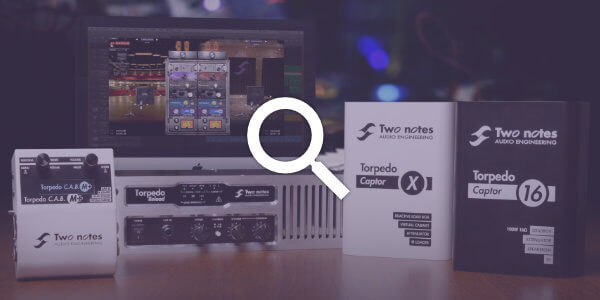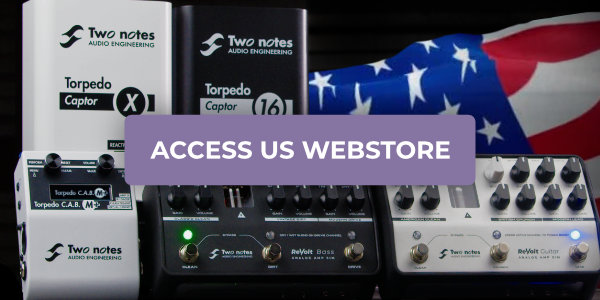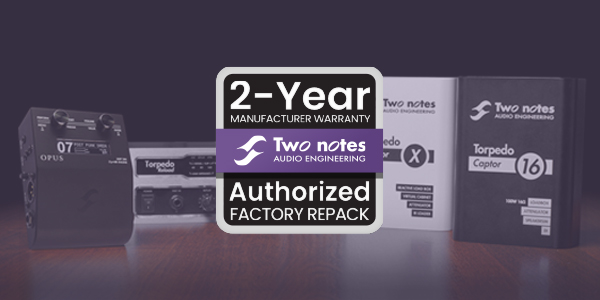When getting an unwanted distortion from your signal chain, the first thing to do is to figure out where it comes from. This can be tricky because most of the products we use when playing the electric guitar (starting with, obviously, the amp) are designed to provide variable amounts of distortion, so part of the task is to separate unwanted distortions from wanted ones. Plus, a typical signal chain when using a Torpedo product will involve a lot of links, from the amp to the monitoring system.
To address this as efficiently as possible, here are a few pointers that we recommend you follow carefully. Some of them are obvious, some are more tricky, but when dealing with a complicated issue, nothing should be overlooked.
As a general rule, start by simplifying your signal chain as much as possible. For example, if applicable, go as simple as amp (or preamp) -> Torpedo -> headphones. This will limit the possible causes of distortion. If everything is OK then, re-integrate the rest of the products to the chain (adding your sound interface, effect pedals, or others…), one by one. With each product added to the chain, check if everything is OK. If not, you may well have found the culprit.
- First of all, check for digital clipping. If you are using a Torpedo Captor X, CAB M, CAB, Live or Studio, check that the red clip LEDs don’t light on the unit or in remote. If they do, first lower the input level of the Torpedo, this can be done with the input potentiometer or switch. If this is not enough, lower the level of the product placed just before the Torpedo. When the input is not clipping anymore, and if the output is still clipping, lower the output level of the Torpedo.
Also check digital clipping on other products, especially on sound interface or in your DAW. Check if any bargraph is indicating clipping somewhere. If so, correct the situation by lowering some level before going further. - Then, check for analog clipping. This may be less direct than digital clipping, because it’s not always indicated by a clip LED, but it’s basically the same phenomenon : a circuit is overloaded by a signal too high. Check every input and output, and make sure not one is overloaded.
- Some processing on the Torpedo can create distortion, like the Power Amp simulation, the compressor, or the Overload (WoS) parameter. Turn them off (or to 0%) to make sure the clipping is not coming from there.
Sometimes, the distortion heard when using a Torpedo is directly coming from the amp or preamp, and is coming to your attention because of the Torpedo, not caused by it. Here are a few pointers to that respect. - First of all, make sure you are using a speaker simulation. The speaker cabinet acts as a huge filter placed after the amp, and removes a lot of frequency content, especially in the high end of the spectrum, where distortion is most heard. In most cases, the smallest distortions will actually be fully removed by the speaker. It is not uncommon that a “clean” sound is clean only because the speaker actually removes the distortion.
When using a Torpedo Captor X, CAB M, Studio, Live, CAB or Captor, make sure the speaker simulation is turned on. Please refer to the user manual of your particular unit for this, they are all available online here.
Additionally, there are a few things to be aware of, depending on the unit. For the Live and CAB, in the Setup menu, check that the Output parameter is set on Wet/Wet (for more details about this, you can refer to this article). For the Torpedo Studio, make sure the Output parameter is set to Stereo, and that the Dry/Wet parameter is set to 100%. When using a Torpedo Captor, make sure you are using the XLR DI Output (there is no speaker simulation on the Line output).
When using a Torpedo product as a load-box outputting a dry sound, without speaker simulation (that can be any Torpedo product, but it’s especially important for the Torpedo Reload and Captor), make sure you are using a speaker simulation before monitoring the signal. Use the Torpedo Wall of Sound plugin or something else. - Tube amps are great and we all love them. In particular, the slow transition from clean to crunchy to distorted to fully overloaded is part of what we love about tube amps. But what this leads to is, there is actually no clear separation between clean and crunch when it comes to tube amps, but a continuum of possible sounds. And most people miss to realize that what we usually call “tube warmth” is, at least partially, due to some kind of distortion.
What this means is: as said just before, it’s not uncommon to have distortion in a “clean” sound. Don’t be fooled by the label on your amp or by what someone told you : a “clean” amp or channel will almost always have a small amount of distortion. And this plays a role with what comes next. - The Torpedo product (and any load-box for that matter) can easily lead to playing your amp harder than usual. When the amp is connected to a loudspeaker, you quickly get to a really loud sound, and you get a direct audio feedback from it. You may be reluctant to really hit your strings hard when what you get in return is walls trembling and ears bleeding! By removing this feedback, and the sense of actual power coming out of the amp, it is really easy to play the amp louder, and so, to make the amp saturate more. Even when using the same settings you would when playing on a real loudspeaker, you could still hit the strings harder.
To prevent this, you can simply connect a speaker cabinet into the Thru output of the Torpedo, and check the direct sound of the amplifier, in order to see if the distortion is coming from the amp or not. - Finally, you should take into account that the Torpedo speaker simulation includes a microphone. It does not sound and behave like playing in front of your speaker cabinet, but rather like placing a microphone in front of the speaker and listening to what the microphone picks up. And this miking process can produce what we call a “magnifying effect” : some components of the sound may be more present, while others may be reduced. It is therefore possible to notice some components in the sound that were already there, but were not noticed.
This effect may be amplified by the fact that the Torpedo will change the speaker you use, and speaker cabinets each have very unique sonic signature. Simply changing it has a major impact on the sound, and this can easily change your reference point.
To study this, and check if the distortion you are hearing coming out of the Torpedo is actually coming (or not) from the amp itself, what you can do is a double miking of the amp, both with a real microphone in front of the speaker cabinet, and with the Torpedo. In more details
Connect the amp to the Torpedo, and aspeaker cabinet to the Thru of the Torpedo. Place a microphone in front of the cabinet, and connect it to your mic pre and sound interface. On the Torpedo, or in the Wall of Sound plugin, choose approaching parameters : same cabinet (or similar), same microphone, same positionning. Record the two sounds, and you will be able to compare them and see if the distortion comes from the amp or the Live.




